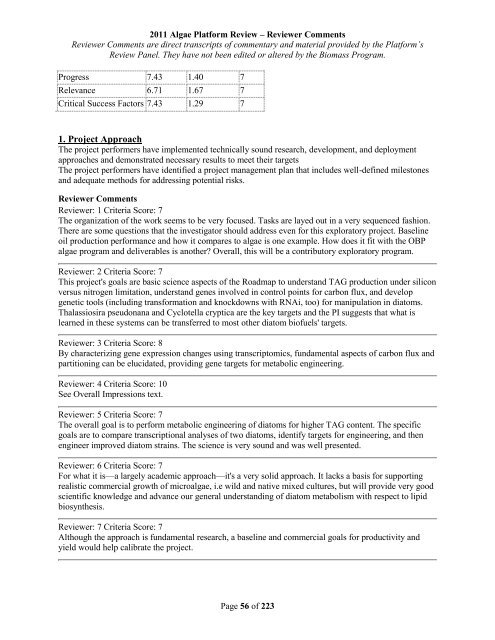Reviewer Comments - EERE
Reviewer Comments - EERE
Reviewer Comments - EERE
You also want an ePaper? Increase the reach of your titles
YUMPU automatically turns print PDFs into web optimized ePapers that Google loves.
2011 Algae Platform Review – <strong>Reviewer</strong> <strong>Comments</strong><br />
<strong>Reviewer</strong> <strong>Comments</strong> are direct transcripts of commentary and material provided by the Platform’s<br />
Review Panel. They have not been edited or altered by the Biomass Program.<br />
Progress 7.43 1.40 7<br />
Relevance 6.71 1.67 7<br />
Critical Success Factors 7.43 1.29 7<br />
1. Project Approach<br />
The project performers have implemented technically sound research, development, and deployment<br />
approaches and demonstrated necessary results to meet their targets<br />
The project performers have identified a project management plan that includes well-defined milestones<br />
and adequate methods for addressing potential risks.<br />
<strong>Reviewer</strong> <strong>Comments</strong><br />
<strong>Reviewer</strong>: 1 Criteria Score: 7<br />
The organization of the work seems to be very focused. Tasks are layed out in a very sequenced fashion.<br />
There are some questions that the investigator should address even for this exploratory project. Baseline<br />
oil production performance and how it compares to algae is one example. How does it fit with the OBP<br />
algae program and deliverables is another? Overall, this will be a contributory exploratory program.<br />
<strong>Reviewer</strong>: 2 Criteria Score: 7<br />
This project's goals are basic science aspects of the Roadmap to understand TAG production under silicon<br />
versus nitrogen limitation, understand genes involved in control points for carbon flux, and develop<br />
genetic tools (including transformation and knockdowns with RNAi, too) for manipulation in diatoms.<br />
Thalassiosira pseudonana and Cyclotella cryptica are the key targets and the PI suggests that what is<br />
learned in these systems can be transferred to most other diatom biofuels' targets.<br />
<strong>Reviewer</strong>: 3 Criteria Score: 8<br />
By characterizing gene expression changes using transcriptomics, fundamental aspects of carbon flux and<br />
partitioning can be elucidated, providing gene targets for metabolic engineering.<br />
<strong>Reviewer</strong>: 4 Criteria Score: 10<br />
See Overall Impressions text.<br />
<strong>Reviewer</strong>: 5 Criteria Score: 7<br />
The overall goal is to perform metabolic engineering of diatoms for higher TAG content. The specific<br />
goals are to compare transcriptional analyses of two diatoms, identify targets for engineering, and then<br />
engineer improved diatom strains. The science is very sound and was well presented.<br />
<strong>Reviewer</strong>: 6 Criteria Score: 7<br />
For what it is—a largely academic approach—it's a very solid approach. It lacks a basis for supporting<br />
realistic commercial growth of microalgae, i.e wild and native mixed cultures, but will provide very good<br />
scientific knowledge and advance our general understanding of diatom metabolism with respect to lipid<br />
biosynthesis.<br />
<strong>Reviewer</strong>: 7 Criteria Score: 7<br />
Although the approach is fundamental research, a baseline and commercial goals for productivity and<br />
yield would help calibrate the project.<br />
Page 56 of 223




